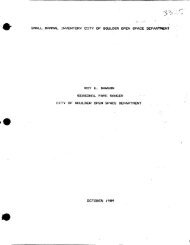Suzy Ageton George Karakehian KC Becker Tim ... - City of Boulder
Suzy Ageton George Karakehian KC Becker Tim ... - City of Boulder
Suzy Ageton George Karakehian KC Becker Tim ... - City of Boulder
You also want an ePaper? Increase the reach of your titles
YUMPU automatically turns print PDFs into web optimized ePapers that Google loves.
Industrial – Service: Service industrial areas primarily used to provide to the<br />
community a wide range <strong>of</strong> repair and service uses and<br />
small-scale manufacturing uses.<br />
Industrial – General: General industrial areas where a wide range <strong>of</strong> light<br />
industrial uses, including research and manufacturing<br />
operations and service industrial uses are located.<br />
Industrial – Manufacturing: Industrial manufacturing areas primarily used for<br />
research, development, manufacturing, and service<br />
industrial uses in buildings on large lots.<br />
Industrial – Mixed Services: Industrial areas on the edge <strong>of</strong> a main street commercial<br />
area, which are intended to provide a transition between a<br />
main street commercial area and established industrial<br />
zones.<br />
While the manufacture <strong>of</strong> beer, wine and distilled spirits are allowed in all <strong>of</strong> the above districts,<br />
<strong>Boulder</strong> has traditionally limited commercial uses in these zones. Other than service industrial or<br />
vehicle-related uses, most retail sales in the industrial districts are considered accessory to the<br />
primary industrial use <strong>of</strong> the land and 1) must be subordinate to and customarily found with the<br />
principal use <strong>of</strong> the land, and 2) operated for the benefit or convenience <strong>of</strong> the employees and<br />
customers or visitors to the principal use <strong>of</strong> the property (Section 9-16-1, B.R.C. 1981).<br />
Restaurants or food service at a manufacturing site are further restricted in their location, size<br />
and market in order to limit the commercial use <strong>of</strong> the industrial properties, prevent loss <strong>of</strong><br />
manufacturing space in the city and to retain the vitality <strong>of</strong> the city’s commercial areas and retail<br />
base.<br />
Some <strong>of</strong> the current uses at the breweries, distilleries and wineries are allowed either by-right<br />
(e.g. tap and tasting rooms) or through review (see table below). All restaurants in the industrial<br />
districts are subject to specific use standards and must go through Administrative Review<br />
(Section 9-2-2, B.R.C. 1981). The intent <strong>of</strong> the use standards for restaurants, as outlined in<br />
Section 9-6-5(b)(3) <strong>of</strong> the code is to limit the amount <strong>of</strong> commercial use in the industrial districts<br />
and to prevent negative impacts on parking and neighboring residential zones.<br />
Current Uses at<br />
Breweries, Distilleries<br />
and Wineries<br />
1. Manufacturing uses <<br />
15,000 square feet<br />
2. Manufacturing uses ><br />
15,000 square feet<br />
3. Tap and tasting rooms<br />
where the products are<br />
served (beer, spirits, or<br />
wine)<br />
Current Code Requirements (Industrial Zones)<br />
Allowed in all industrial zones<br />
Allowed in IG, IM<br />
Prohibited in IMS<br />
Requires Use Review in IS<br />
Considered an accessory by-right use – subordinate to and<br />
customarily found with the principal use.<br />
4. Restaurants Considered a “Conditional Use” in the industrial zones and<br />
subject to use standards in B.R.C. 9-6-5(b)(3) (see below)<br />
Agenda Item 5B Page 15















